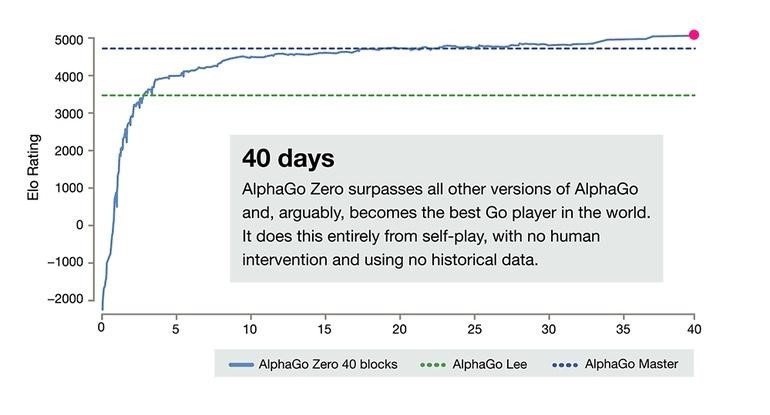ARTIFICIAL INTELLIGENCE
By Suvir Rathore and Farhia Rashid
The latest evolution of AlphaGo, AlphaGo Zero, used reinforcement learning to quickly surpass all previous evolutions, overtaking AlphaGo Lee in just 3 days. Unlike its previous evolutions, it used a new technique rather than training from human games, it taught itself through random practices eventually learning several techniques that weren’t even apparent to us. After defeating the previous AlphaGo 100 to 0 it quickly became famous and the application of the AI event meant that it could master chess in just under four hours. The results were 25 wins playing as white and 3 as black against the previous master program, Stockfish, which got 0 wins (for the rest were all draws) “It’s like an alien civilisation inventing its own mathematics,” said computer scientist Nick Hynes from MIT in October.
The technique of reinforced learning has such great potential, that the future applications are unimaginable as AlphaGo Zero. In fact reinforced learning was also used in Google’s AutoML, which was tasked with generating its own AIs by developing a child network to do a specific task through its own extensive controller neural network, the result being a 4% more efficient system and a 1.2% more accurate NASNet. The future of this can mean completing such tasks can be performed by almost anyone as coding an AI that develops specific AI is much easier than traditional techniques, as well as being more efficient.
Amongst Elon Musk’s extravagant visions and accomplishments, building Australia’s Mega battery in 100 days was simply the beginning. Even though he claims that we only have a 10% chance of making AI safe, he has continued to pursue this vision in his Tesla models, with one of the newest models, the Tesla Model 3, being able to navigate you around traffic, use AI for its own driving and even predict where you want to go! The autopilot autonomous driving system can get around to places without any human involvement as some of the best AI engineers are working on it.
The Turing Test
The Turing Test was developed by Alan Turing in 1950, and is designed to test a machine’s ability to exhibit intelligent behaviour interchangeable with that of a human. A human evaluator judges conversations between a human and a machine that is designed to generate human-like responses. The evaluator is aware that one of the two partners in the machine is human and one is a machine. The conversation is limited to a text-only channel, such as a keyboard, so that the result is not dependent on the machines ability to speak. If the evaluator is unable to differentiate the machine from the human, the machine is said to have passed the test. The test does not check if the machine gives correct answers, but how closely its answers resemble those a human would give.
Turing introduced the test in his paper: “Computing Machinery and Intelligence”, published in 1950. He opens with the words: “I propose to consider the question, ‘Can machines think?’” Turing then replaces this question with another, very closely related to it but expressed in less ambiguous wording: “Are there imaginable digital computers which would do well in the imitation game?”
The imitation game is a party game, in which a man and a woman go into separate rooms and guests try to tell them apart by writing a series of questions and reading the responses. In this game both the man and the woman aim to convince the guests that they are the other. Turing described his version of the game as:
‘We will now ask the question, “what will happen when machine takes the part of A in this game? Will the interrogator decide wrongly as often when the game is played like this as he does when the game is played between a man and a woman?”
Since Turing introduced his test, it has been highly influential, and widely criticised, and it has become an important concept in the philosophy of artificial intelligence.
In June 2014, a computer program called Eugene Goostman, which stimulates a 13-year-old Ukrainian boy, was said to have passed the Turing Test. No computer had passed the test before under the conditions. However, some AI experts have disputed the victory, suggesting that the competition was weighted in his favour.
The Turing Test is said to be successfully passed if the computer is mistaken as a human more than 30% of the time during a series of 5-minute keyboard conversations. Eugene convinced 33% of the judges at the Royal Society in London that it was human. Other AI systems that also competed included: Cleverbot, Elbot, and Ultra Hal.
Eugene was created by Vladimir Veselov, who was born in Russia and lives in the United States, and Eugene Demchenko, who was born in Ukraine and lives in Russia.


